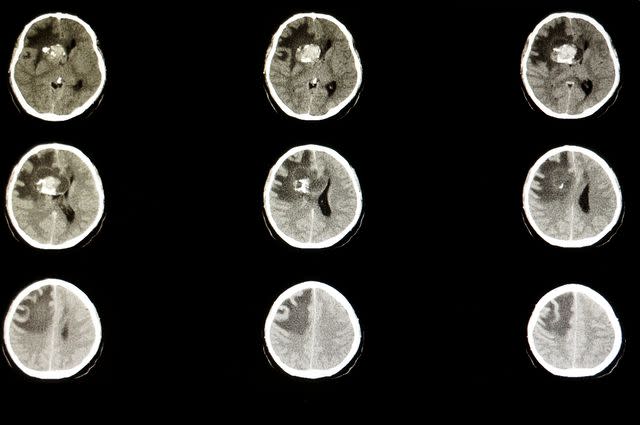Oligodendroglioma Prognosis and More
Medically reviewed by Brigid Dwyer, MD
Oligodendrogliomas are rare tumors found in the brain or spinal cord. These tumors develop from cells called oligodendrocytes, which make up protective tissue in the brain and spine.
Oligodendrogliomas can be successfully treated, but the outlook varies depending on the location and grade of the tumor.
This article will discuss the types, symptoms, causes, prognosis, and treatment options available for oligodendrogliomas.

Getty Images
Types of Oligodendroglioma
Oligodendrogliomas can be cancerous (malignant) or noncancerous (benign). They usually form in the frontal or temporal lobes of the brain but occasionally occur in the spinal cord.
Oligodendrogliomas are categorized into two types, based on how fast the tumor grows, including:
Grade II (low grade) oligodendrogliomas: These tumors grow slowly and usually only affect nearby tissue. In most cases, they develop for years before a person notices any symptoms.
Grade III (high grade) anaplastic oligodendrogliomas: These tumors are cancerous and fast-growing.
What Do Oligodendrogliomas Look Like?
Oligodendrogliomas are usually soft, grayish-pink tumors. They commonly contain mineral deposits, cysts, or areas of hemorrhage. These tumors usually have some swelling around them.
Oligodendroglioma Symptoms
A seizure is the most common symptom of an oligodendroglioma tumor. About 60% of people experience a seizure before being diagnosed with an oligodendroglioma.
Other symptoms may include:
Memory or cognition problems
Weakness
Numbness
Balance or movement issues
Language difficulties
Changes in behavior or personality
Causes
Researchers don’t know the exact cause of oligodendrogliomas, but genetics seem to be a factor.
Certain genetic mutations, specifically abnormalities involving the loss of chromosomes 1p and 19q, appear to play a role in the development of oligodendrogliomas.
Being exposed to significant radiation from X-rays or cancer treatment may also increase your chances of developing an oligodendroglioma.
Who Is Likely to Develop Oligodendrogliomas?
While they can affect anyone, oligodendrogliomas are most common in adults aged 35-44. They occur more often in males and are rare in children.
Diagnosis
The following tests are performed to diagnose an oligodendroglioma:
Neurological exam: A physician will assess coordination, balance, reflexes, weakness, and vision or hearing problems.
Imaging scans: Magnetic resonance imaging (MRI) or computed tomography (CT) scans may be done to help determine the size and location of the tumor.
Biopsy: Removing a sample of tissue from the suspected tumor and sending it to a lab for analysis. This test can help identify the type and grade of the tumor.
Other specialized tests may be performed to help a physician diagnose an oligodendroglioma.
Treatment
Treatments for an oligodendroglioma depend on the grade, type, and location of the tumor.
Treatment options include:
Surgery: If the tumor is in a safe location, surgery can be performed to remove it. During the procedure, surgeons carefully try to cut out as much of the tumor as possible without damaging healthy tissue.
Radiation: Radiation therapy uses high-energy particles to destroy cancer cells. It’s often used after surgery to target remaining tumor cells.
Chemotherapy: Drugs are used to kill cancer cells in the body. Physicians sometimes recommend this treatment before or after radiation therapy to destroy any residual cancer cells that are left after surgery or radiation.
For someone who can't undergo surgery, chemotherapy and radiation may be used together as the primary treatment of choice.
Clinical Trials for Oligodendrogliomas
Clinical trials are currently underway to test newer treatments for oligodendrogliomas. Currently, researchers are looking at targeted drugs, immunotherapies, and chemotherapies. Talk to your physician to see if you qualify for a clinical trial.
Prognosis
Oligodendrogliomas are estimated to account for 1.3% of brain tumors in the United States with approximately 1,100 new diagnoses each year.
Your oligodendroglioma prognosis will depend on the location of the tumor, the selected treatment, your overall health, age, and other factors. It’s important to remember that statistics may not reflect your specific case.
The 5-year relative survival rates for oligodendroglioma by age group are:
Children (ages 0-14): 94.0%
Adolescents and Young Adults (ages 15-39): 92.2%
Adults (ages 40+): 76.8%
Some people with oligodendrogliomas live without symptoms. Others will need ongoing treatment to control the growth and spread of their tumor.
What Questions Should I Ask My Healthcare Provider?
If you are diagnosed with an oligodendroglioma, be sure to ask your physician or oncologist:
Is my tumor cancerous or noncancerous?
What type of treatment do you recommend?
What are the chances that the treatment will cure my condition?
How can I manage the side effects of treatment?
Am I a candidate for a clinical trial?
Coping
If you’ve been diagnosed with a brain tumor, such as an oligodendroglioma, it’s normal to feel overwhelmed.
You may have to deal with speech, thinking, balance, cognitive, or motor skill challenges. Additionally, you may experience seizures or headaches that interfere with your daily life. Certain therapies and medications are available for many of these problems.
It’s also important to take care of yourself, which includes eating a healthy diet, exercising if you can, and getting enough sleep.
Some people find that joining an online or in-person support group can help them better manage their condition. These groups connect you with others who are going through the same thing. Some organizations to check out include T.H.E. BRAIN TRUST Oligodendroglioma Support Group and The American Brain Tumor Association Brain Tumor Support Groups page, which can help you to locate support by state, online, and by telephone.
Summary
Oligodendrogliomas are rare brain tumors that cause neurological symptoms. Surgery, chemotherapy, and radiation are typical treatment methods for this condition. The 5-year survival rate for oligodendrogliomas is encouraging and new therapies are currently being investigated. Getting an accurate diagnosis and the appropriate treatment improves your outlook for oligodendrogliomas.
Read the original article on Verywell Health.

